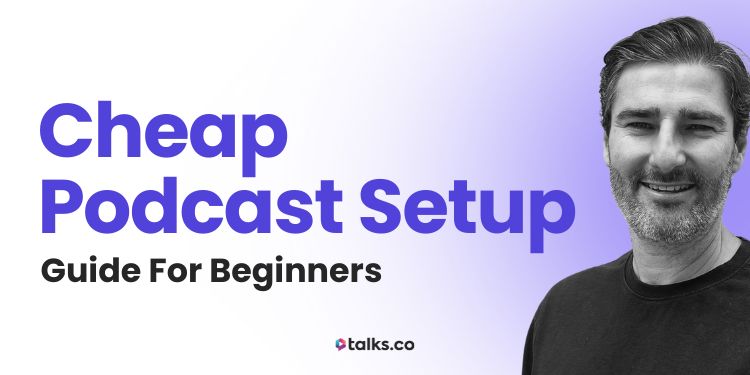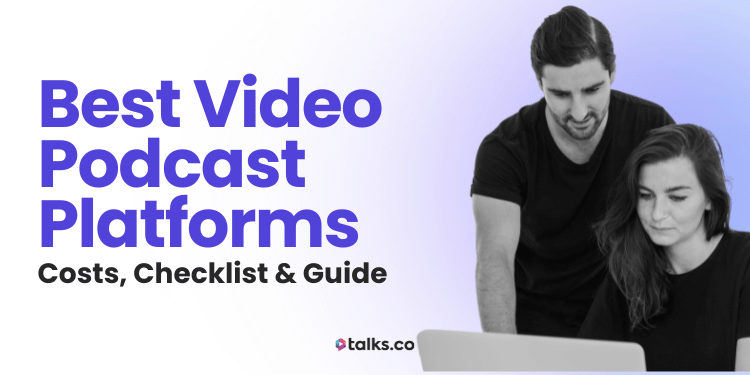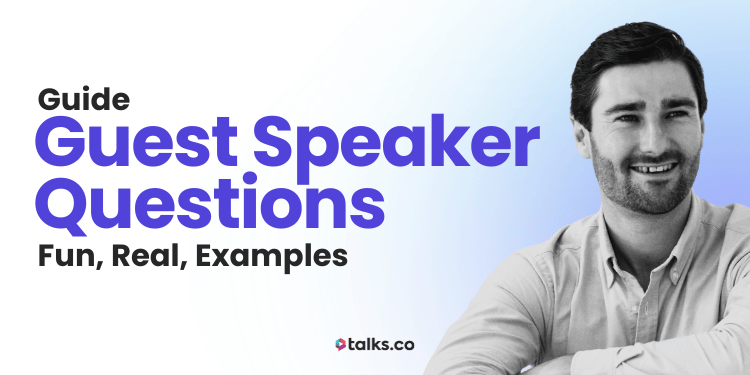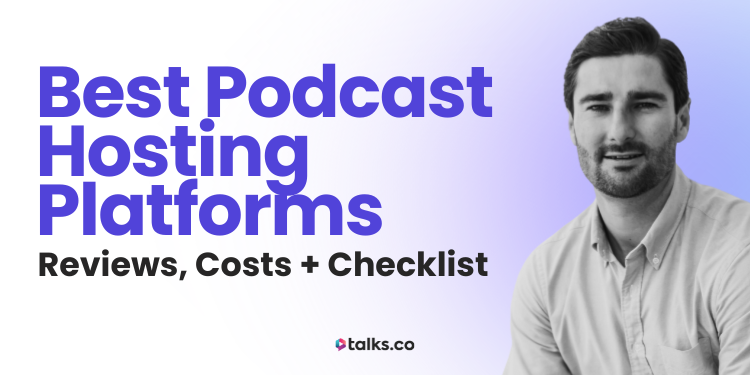Starting a podcast doesn’t have to cost a fortune. And if you’re here, you’re probably looking for the simplest, most affordable way to get things off the ground. You’re in the right place.
I’ve done 60+ podcast interviews and over 400 summit interviews. Never used a fancy studio. Never needed one. Most of the time, it was just me, a decent mic, and whatever quiet corner I could find between Australia and Sweden.
The setup was simple, cheap, and it worked.
In this guide, I’ll show you exactly what you need for a cheap podcast setup. These are tools I’ve used or would recommend – just what actually works to get started without blowing your budget.
Let’s get you set up.
How Much Does It Cost to Set Up a Podcast?

The cost to set up a podcast can range from $0 to several thousand dollars depending on how simple or polished you want your podcasting equipment setup to be. There’s no one-size-fits-all number, but here’s what most podcasters spend at each level:
- $0-$100: You can start a budget podcast for free or next to nothing. Use your phone’s mic, record your podcast with Zoom, and host on a free podcast hosting service like Spotify for Creators. It won’t sound like NPR, but it works.
- $100-$500: This range covers most beginner setups and podcast gear. You’ll get a good quality USB mic, basic headphones, and a simple editing tool like Podcastle. Plenty of the best podcast shows run on this kind of setup.
- $500-$2000+: Want crisp audio, professional editing, and a studio vibe? You’ll likely invest in the best podcast equipment like an XLR mic with interface, acoustic treatment, paid editing software, and higher-end hosting. Still affordable compared to starting a YouTube channel or building a website-heavy business.
Bottom line? Podcasting is one of the lowest-barrier content formats out there. Start with what you’ve got, and upgrade with additional podcast equipment once your content and audience start growing.
How Much Does It Cost to Set Up a Podcast Studio?
It depends on how far you want to go. You can get started for under $100 if you’re on a tight budget or build out a professional-level setup for $1,000+. The real cost of podcast recording equipment comes down to your goals, format, and how polished you want your sound to be.
Here’s a breakdown of what different recording studio setups and recording equipment might cost:
Entry-level setup: $70-$300
For hobbyists or a first-time podcaster testing the waters.
What you’ll need:
- A solid USB mic (like the Razer Seiren V3 Mini or similar USB mics): $44.98-$99
- Over-ear headphones: $20-$50
- Free software (Audacity, GarageBand, etc.): $0
- Optional: Pop filter, boom arm or tripod stand: $9.99-$50
Mid-tier setup: $301-$700
Great for solo podcasters, coaches, or small teams who want solid quality without going overboard.
What you’ll need:
- Dynamic XLR mic (e.g., Audio-Technica ATR2100x): $79
- Audio interface (Focusrite Scarlett Solo 3rd Gen or similar): $109.99
- Studio headphones (Audio-Technica M30x or similar): $50-$70
- Acoustic foam panels or DIY sound treatment: $12-$100
- Optional: Mic stand, boom arm, shock mount: $80+
Pro-level setup: $1,000+
If you’re running a professional podcast full-time or want the best podcasting production-level quality for video and audio equipment.
What you’ll need:
- Broadcast-quality mic (e.g., Shure SM7B): $439
- Premium audio interface (e.g., Rodecaster Pro II): $699
- Apple Studio Monitor: $1,599
- Full lighting setup (softboxes, ring lights): $100-$300
- 4K camera or DSLR with capture card: $500+
- Soundproofing treatment: $100-$400
Starting a Podcast on a Budget?
Starting a podcast on a budget doesn’t mean settling for poor quality. You just need to focus on the essentials: gear that works, sounds good, and doesn’t drain your bank account.
The truth is, most beginners overthink it. You don’t need a professional studio or expensive setup to sound professional. You just need the right mic, a quiet space, and a few simple tools to get started.
Below you’ll find what you actually need in your podcast starter kit (and what you can skip) so you can launch with confidence and keep your costs low.
Best Cheap Podcast Setup
You don’t need professional equipment or immediately upgrade your equipment to sound sharp when you’re just starting your podcast show. These setups keep it simple, affordable, and good enough to grow with you.
Cheap podcast setup
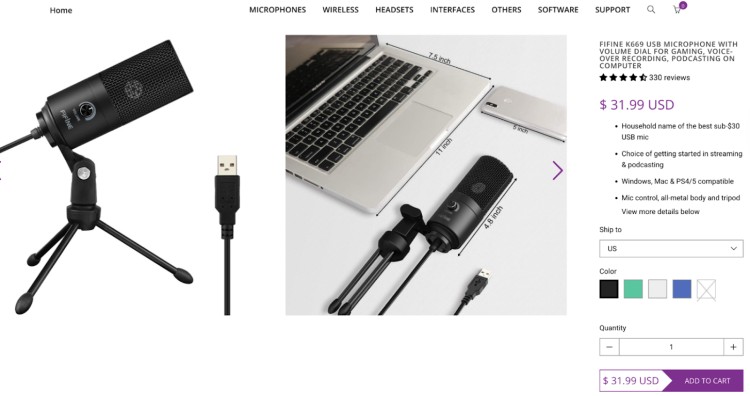
Perfect for solo podcasters starting from scratch and looking for just the necessary equipment for their podcast recording setup.
- Fifine K669B USB microphone: A clear, plug-and-play microphone that costs $31.99.
- Sony MDR-ZX110 headphones: Lightweight and comfortable headphones for under $12.99.
- Audacity: A free, reliable, and easy-to-use podcast software for editing your podcast.
- Aokeo U-pop: A pop filter that helps reduce harsh sounds, priced under $7.99.
Total: $52.97
Cheap podcast setup for 2
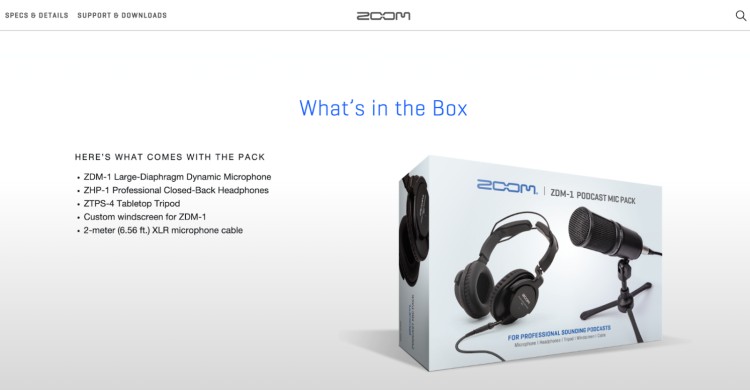
Hosting with a guest or co-host? Here’s a reliable two-person setup.
- Zoom ZDM-1 Podcast Mic Pack (x2): Each $99 podcast equipment bundle pack includes a dynamic mic, closed-back headphones, tabletop tripod stand, windscreen, and XLR cable. Everything you need to sound professional.
- Behringer U-Phoria UMC202HD USB Audio Interface: Delivers quality audio with two XLR inputs, phantom power, and compatibility with major recording software, all for $86.90 on Amazon.
- Tracktion T7 (Waveform Free): A free, full-featured DAW that supports multi-track editing, VST plugins, and pro-level production across Windows, macOS, and Linux.
Total: $284.90
If you want to save even more, you can use two Fifine K669B USB microphones and record on separate laptops or with Zencastr.
Cheap podcast setup for 4
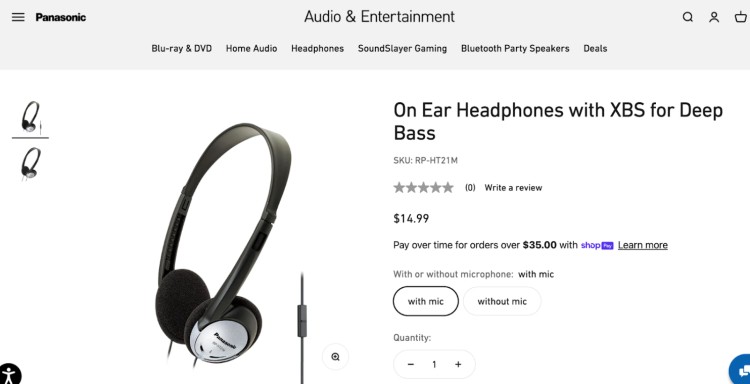
Do you plan to record with a 4-person podcast setup? Here’s a budget-friendly multi-mic setup.
- Behringer XM8500 microphones (x4): These microphones provide excellent value at $13.90 each.
- Behringer UMC404HD interface: This 4-input audio interface provides clean sound and costs $109.
- Panasonic RP-HT21 On-Ear Lightweight Headphones (x4): Surprisingly good clarity for $14.99. Comfortable for short sessions and very budget-friendly for a group setup.
- Pyle Pro Desktop Microphone Stand & Compact Table Tripod Mic Holder Mount with Height Adjustment (x4): Adjustable from 4.7″ to 8.7″, sturdy, compact, and easy to store at just $8.10 each.
Total: $256.96
Cheap podcast equipment
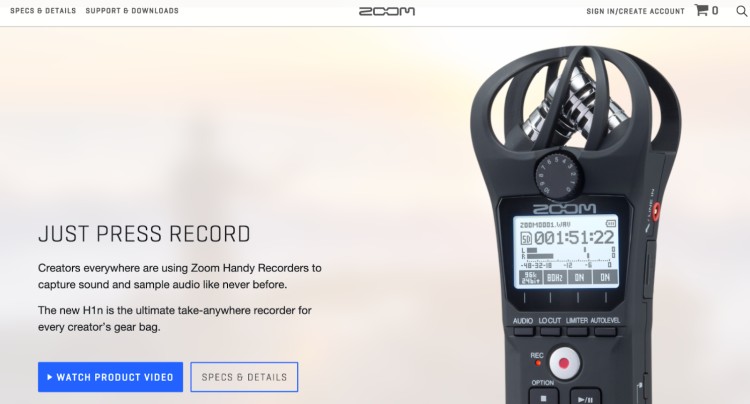
Building piece by piece? Here are solid low-cost picks.
- RØDE NT-USB Mini: Studio-quality USB mic for $99. It’s compact, easy to use, and delivers clean, professional sound. Comes with an internal pop filter, built-in headphone output with zero-latency monitoring, and a detachable magnetic stand.
- Pyle PMXU43BT audio mixer: A 4-channel mixer with Bluetooth, USB recording, and built-in analog effects. It features 16-bit DSP, phantom power, and multiple input/output options, making it ideal for both studio and on-stage use for $93.99.
- Zoom H1n portable recorder: This handheld recorder is great for mobile interviews and is priced at $99.99.
Cheapest Way to Start a Podcast
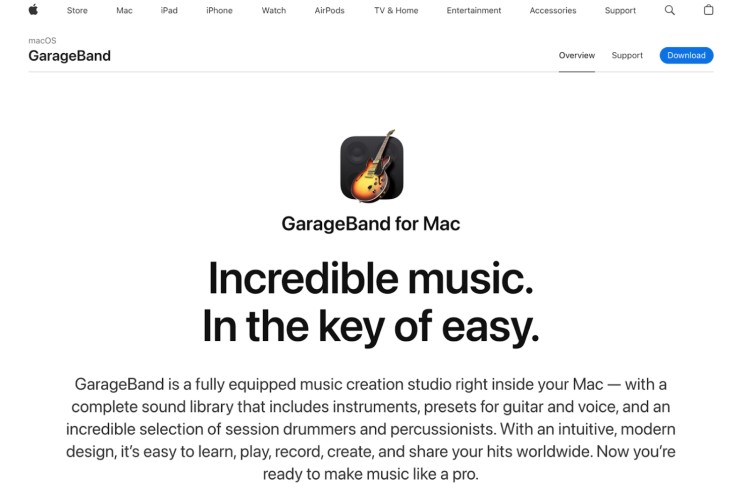
For a pure audio podcast, your main focus should be on getting good sound quality. You don’t need a camera or fancy lighting, just the right tools to record and edit clean audio.
- Laptop, iPhone, or Android: Your device already comes with a built-in microphone, which is good enough for your first episodes.
- Free recording and editing software: GarageBand (for Mac users) is an easy-to-use tool for recording and editing, while Ocenaudio (for Windows and Mac) is a simple, effective editor that’s perfect for beginners.
That’s it! With these basics, you can start recording and editing your podcast right away, no expensive equipment required.
Setting Up a Video Podcast
With video, it’s about balancing visuals and audio. You’ll need a bit more focus on how you look on camera, but still, it doesn’t have to stretch your wallet thin
Cheap video podcast setup
If you’ve got a phone or laptop, you’re good to go.
- Smartphone or laptop: The rear phone camera often looks better than a built-in webcam. Use daylight or a lamp for lighting. Check out how to record a podcast on your phone.
- Built-in mic or wired earbuds: Not studio quality, but it’ll do the job when you’re just getting started.
- Free editing software: iMovie (Mac) or Clipchamp (Windows) lets you trim, clean up, and export video without a fuss.
Total: $0 (assuming you already own the gear).
Budget video podcast setup
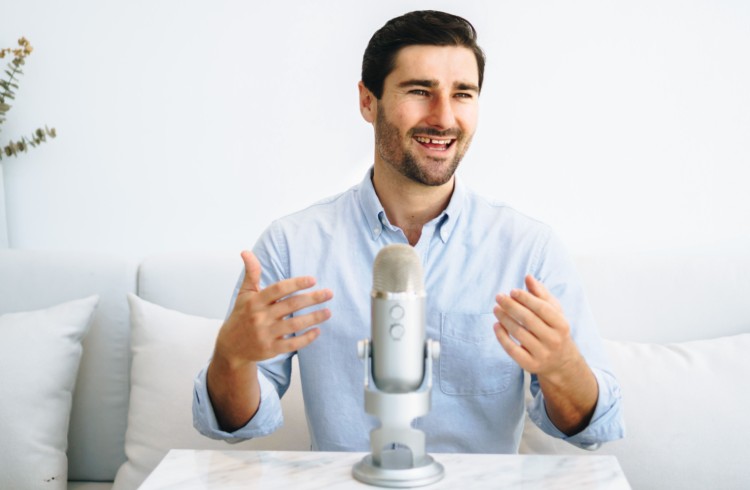
What I used when I started doing and still a solid option today for video podcasts.
- Zoom: I started with Zoom back in 2015. These days most podcast hosts use Riverside during their interviews. The video and audio quality are just better.
- Blue Yeti USB mic: I’ve had mine since 2015. It’s durable, easy to use, and sounds great for $104.99. Most XLR and USB mics are good enough when you need to record a podcast.
- Logitech C920 webcam: I used this for years. It’s still one of the best budget webcams out there with a clean 1080p video for $69.99.
- Ring light: I travel with a basic ring light. It makes a huge difference when you don’t have good natural light. You can find one for $29.77 on Walmart or Amazon.
Total: $204.75
Simple video podcast setup

This is what I use now. It’s a portable setup with pieces of equipment that are easy to pack and high-quality enough to repurpose every podcast content for social media.
- StreamYard: You’ll find a lot of podcast hosts record interviews remotely using StreamYard. It’s reliable and offers high-quality video and audio. Basic plan starts at $25.
- Shure MVL Lavalier Microphone: Personally, I use a simple lapel mic when I travel. It’s small, portable, and still gives me clear audio. You can get the Shure MVL for just $76.
- Canon EOS Rebel T7 EF-S: At home, I use a DSLR for crisp 4K video. It’s great for repurposing content into short clips. The Canon EOS Rebel works just as well at $479.99.
- OCF Softbox Square: I keep something similar to these $99 softboxes in my home setup. Soft lighting is an affordable option that makes your video look way more polished.
Total: Starts at $679.99 (or more, depending on how much you upgrade).
Basic Setup for Podcast
You don’t need much to get started. The key is to focus on sound quality first, then build from there. Here’s what you actually need to launch.
5 Essential tools for budget podcasting
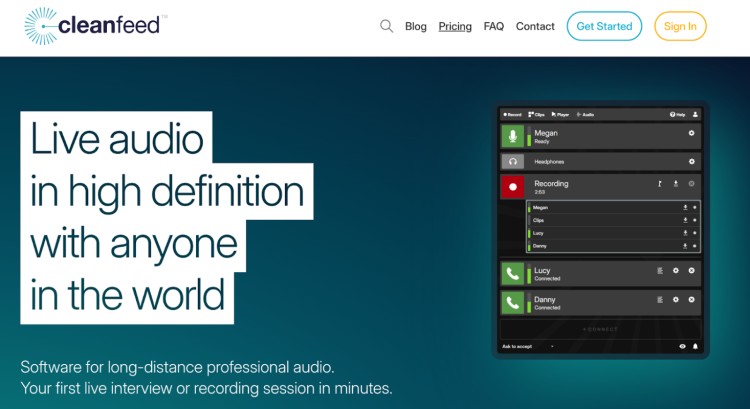
These are the minimum tools I’d recommend if you want to sound professional without going overboard with your budget.
- Samson Q2U microphone: It’s both USB and XLR, so you can plug in directly now and upgrade later. Clean sound for around $69.99.
- Audio-Technica ATH-M20x: Closed-back, comfortable, and reliable for podcast editing and monitoring, usually under $40.
- Cleanfeed: A browser-based recorder built for podcasters. The free version works well for one-on-one interviews and remote recording calls.
- JBER 12-Pack Acoustic Foam Panels or blankets: You don’t need a studio. A few foam panels (or even thick blankets) can help deaden echoes in your podcast room setup. A pack of 12 acoustic foam panels costs $12.59 on Amazon.
- Gator Frameworks Mini Tripod Desktop Wired Mic Stand: Keeps your mic stable and stops handling noise. You can grab one for $9.99.
10 Tips for budget-friendly podcasting
Starting a podcast doesn’t have to be expensive. With the right tools and a little creativity, you can launch a high-quality show on a budget, and these tips will help you get there without overspending.
- Start with what you have: Your phone mic, laptop camera, and free software are enough to launch. You can always upgrade later.
- Buy gear that grows with you: A good USB mic can serve you for years. I still have my Blue Yeti from 2015.
- Use free tools: There’s no need to pay for software upfront. Tools like Ocenaudio or GarageBand (for Mac users) do the job.
- Record locally: Even if you’re doing remote interviews, record your own podcast audio locally for better quality.
- Turn your closet into a studio: Clothes dampen echo and background noise. It’s free sound treatment.
- Record in batches: Set aside a block of time and record a few episodes in one go. It saves time and helps you stay consistent.
- Keep editing simple: Don’t overthink it. Cut out major mistakes, level the audio, and keep it moving.
- Use natural light or a cheap ring light: No need for a full studio setup. Just make sure your face is well-lit.
- Stick to one format at first: Interview, solo, or co-host, pick one. Switching formats adds complexity and gear costs.
- Repurpose content: Use clips from your podcast for social media, blogs, or newsletters. It’s an easy way to get more mileage from each episode.
What Is the Average Cost of Starting a Podcast?
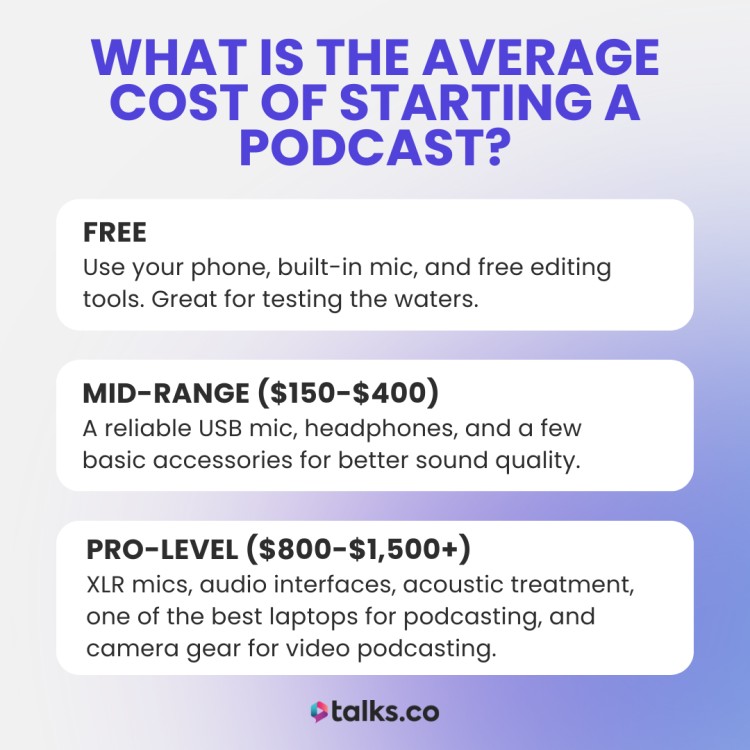
It depends on how scrappy or polished you want to go. Here’s a quick look at the typical ranges:
- Free: Use your phone, built-in mic, and free editing tools. Great for testing the waters.
- Mid-range ($150-$400): A reliable USB mic, headphones, and a few basic accessories for better sound quality.
- Pro-level ($800-$1,500+): XLR mics, audio interfaces, acoustic treatment, one of the best laptops for podcasting, and camera gear for video podcasting.
Pick the tier that fits your comfort level. There’s no rule that says you have to go all in from day one.
Where Can I Start a Podcast for Free?
If you’re just getting started and not quite ready to go all in just yet, good news: you don’t have to.
There are a few platforms that let you record, host, and distribute your podcast for free. They’re built for beginners and keep things super simple, which is exactly what you want early on.
Here are some solid free options to launch your podcast:
- Spotify for Creators: A go-to for beginners. Lets you record, edit, host, and push episodes to Spotify and other major platforms in just a few clicks. 100% free.
- Podbean: Free plan includes 5 hours of storage and 100GB bandwidth. Great for testing the waters, but limited if you plan to post regularly.
- Buzzsprout: The free plan gives you 2 hours of uploads a month, but episodes only stay up for 90 days. Good for experimenting.
- RedCircle: Free core plan with unlimited hosting and distribution. You also get access to tools like donations and subscriptions to monetize your podcast. Paid plans come with a 7-day free trial if you want more features later and upgrade your podcast.
Each of these gives you enough to get up and running without having to worry about monthly fees.
Start where it’s simple. You can always upgrade later once you’ve got some momentum.
Start Loud, Spend Less
You don’t need fancy gear, a studio team, or a production budget to make a podcast that gets heard. A cheap podcast setup can still sound high-quality if you invest wisely, starting simple and buying podcast equipment you need only when it actually makes sense.
What matters more than the gear during podcast production is showing up consistently, having something real to say, and getting your voice in front of the right people.
And that’s exactly what your free Talks Creator profile helps with. No chasing, no cold pitching. Just one profile that gets you discovered and booked by the hosts your dream audience already listens to.
Find amazing podcast guests for your show and get booked on other people’s podcasts, just create your Talks profile today.
